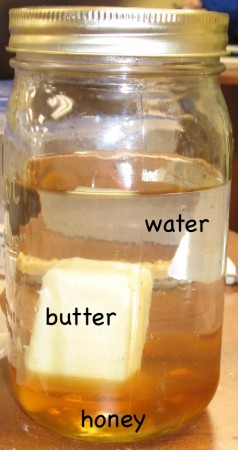
When we bake bread we usually put all the wet ingredients –honey, water and butter– into a mason jar. If you do it carefully, the substances stratify: the honey forms a nice layer at the bottom as the water floats above it; and the butter, which has the lowest density, floats on top. You need to be careful about, since the honey can dissolve into the water if it is mixed, however, with a little careful pouring, this is an easy way to demonstrate density differences.
The butter, however, can be most interesting. If you put the butter in last, it will float on top of the water as it should. However, if you put it in first and then pour the honey on top of it, or even if you put it in second, after the honey is already in the jar, the butter will stick in the viscous honey and not float to the top.
What’s really neat, is what happens when you microwave the mixture with the butter stuck in the honey. The solid butter melts, and, because it’s less dense than the water above it, as well as because water and oils (like butter) don’t mix, little bubbles of butter will form and float upwards to the top. It’s like a lava-lamp only faster. And, in the end, the butter forms a liquid layer floating on the water.